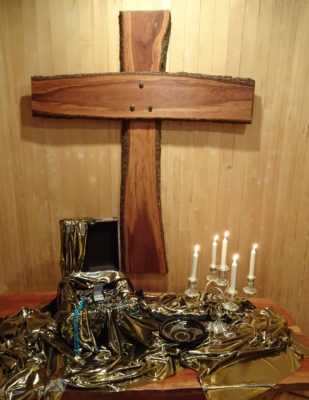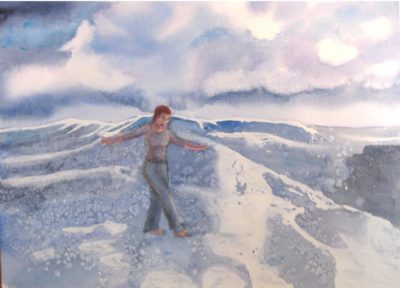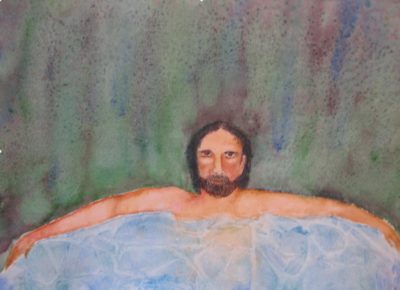August 13, 2017
Tenth Sunday After Pentecost
When Ken asked me a few weeks ago to preach today I almost said “no” because I wasn’t sure I would be able to prepare a sermon in time. I usually give myself more advance time than a few weeks so that I can read and think and let things ferment in there for a while before I start writing. But when I saw what the gospel reading was for today I knew I had to say yes. It is one of my very favorite stories and one I often think of as a metaphor for my life.
People often talk about this story in a “glass half empty” way. Peter tried to walk on water and failed because he didn’t have enough faith. I don’t think of it that way at all. I think of it as a “glass half full” story, or, actually, more of a “glass three-quarters-full” story.Before I start talking about the story of Peter walking on water, I want to give a little personal background. The reason I think of today’s gospel story as a metaphor for my life is that I have lived most of my life on an insecure foundation. My mother was a single working parent who raised me alone and put me through college with a quite modest income. This was in the days when being divorced was a stigma. For much of my childhood we lived in Post-WWII Germany where the bombed-out buildings and ever-present threat of Russian invasion were a constant reminder of how fragile life is. We had a lot of fun, however, and whenever things took a bad turn (for example, when we had to be evacuated from Berlin in the airlift because of the Russian blockade), my mother would always say, “Oh boy, another adventure!” – as if it were an unexpected gift.
As an adult I became, like my mother, a divorced single parent, also with one child. The accompanying financial insecurities only increased when I adopted a second child. Money was tight and both children were difficult. Sometimes it seemed as if we just went from one crisis to another, but we had a lot of fun along the way and I always trusted that everything would somehow work out. I did my best to treat mishaps as adventures.
Now my daughter is the third generation to be a single parent; and she has three children. She is a bachelor’s-level social worker and works at jobs that really don’t pay enough to support her family, which increases my financial insecurity when I have to help her. But we’ve gotten through numerous “adventures” and are still okay. I pray a lot.
When I wrote my spiritual autobiography to read out loud so that I could become a Steward, I used the metaphor of walking on water to describe my life. Because I like combining words and pictures (I presented my spiritual autobiography as a slide show), I painted a picture of myself walking on water. It shows me, with my arms outspread walking, on giant waves in a stormy sea.
Enough about me for now. Getting back to Peter, let me tell you why I think today’s gospel reading is a story about Peter’s faith, not one about Peter’s lack of faith. While the other disciples trembled in fear, Peter trusted that the ghostly apparition appearing in the distance during a terrifying storm was really Jesus. Peter was willing to demonstrate his faith by trusting Jesus to bear him up while he walked toward him on the stormy waves. That was how Peter was. He was one of the first disciples called by Jesus and when Jesus said “Follow me,” he left everything behind and followed Jesus without thinking twice. Even though he made a lot of mistakes, he was a brave and loyal disciple.
In today’s story, when Jesus said, “Come,” Peter stepped out of the boat and walked on water. The Bible story doesn’t tell us how long Peter walked on water. The story says Jesus appeared in the distance, walking toward the boat, so it could have been a long time. But it could have been a short time. It doesn’t matter. He walked on water! How often does that happen?
But it was a terrible storm, and Peter became frightened. His faith wavered. As he began to sink under the waves, he said “Lord, save me!” By now he was close enough to Jesus that Jesus could just reach out his hand to help him. Peter had walked all that way and even though his faith faltered he still trusted Jesus to keep him from sinking. Then (I don’t know how you understand this part of the story but this is how I understand it), they walked back to the boat. Hand in hand. On water.
Jesus said, “Ye of little faith, why did you doubt?” This could be just one of many times when Peter is used as a dramatic foil in the Bible to highlight Jesus’s virtues. But I don’t think Jesus was talking to Peter. In fact, I wrote a little poem about this for my mission group. I bring a poem each week, usually someone else’s, for our time of meditation. The poem I wrote about Peter goes like this:
When Jesus said “Oh ye of little faith,”
it’s easy to assume he meant Peter,
the ever-present fall guy.
But, translations aside,
“ye” is a plural pronoun.
I think he was talking to the disciples
who never even got out of the boat.
In Mark 9, Jesus tells the father of a child he is about heal from epilepsy, “If you can believe, all things are possible to him who believes.” The father responds: “I believe; help my unbelief.” In the gospel story for today, Peter believed and he asked Jesus to help his unbelief. What more could one ask of a disciple?
I said that walking on water is a metaphor I use to describe my life but aren’t we all walking on water? Don’t we all have times when we believe things will be okay and times when we don’t? Reality is scary and just perceiving it takes an act of faith. In fact, reality as we perceive it with our 5 senses is itself an illusion. Perception itself is something we can only take on faith.
In a Psychology Today article, Pamela Paretsky says:
Our common-sense notion of reality is that our eyes, ears, nose, and fingertips pick up objective reality, but that couldn’t be farther from the truth. Smells, sounds, and colors do not actually exist in the outside world…the reality we experience is constrained by our biology. For example, the umwelt (environment) in which bats exist is entirely different than the umwelt in which human beings exist—even when we are physically in the same space. While our reality is constrained by our sensory capabilities, the reality bats experience is constrained by their different sensory (sonar) capabilities.
So what’s “really” out there? We don’t know. The universe may have more or fewer dimensions than the traditional 3. It may consist of vibrating strings of energy or multiple coexisting levels of reality. All historical times may be occurring simultaneously. Our “reality” may just be a virtual reality created by some computer as in the movie, Matrix. There may be parallel universes. We just don’t know. Yet we go on putting one foot in front of the other, expecting the ground (which is made up more of space between atoms than of matter) to support out feet.
I like to believe that there is a spiritual reality that exists simultaneously with our physical reality. Both are matters of faith, as far as I am concerned. Some have characterized the material world as the “horizontal” dimension of reality and the spiritual world as the “vertical” dimension of reality.
Jean-Paul Bedard, a runner and inspirational writer, has said
The Celtic Christians believed that there were mystical spaces, called “thin places,” where the veil between the holy and the human is traversed. A place in which the physical and spiritual worlds are knit together, and if we are so attuned, we can transcend the ordinary for a glimpse of the infinite. I’m sure you’ve been in such places jarring with kinetic energy, and simply by your presence, you are in some way changed.
My mission group, Learners and Teachers, read and discussed Cynthia Bourgeault’s book, The Meaning of Mary Magdalene, recently. This was a kind of follow up to the course Marjory taught in the School for Christian Growth on the Wisdom literature in the Hebrew Testament. This book, which describes the Christian wisdom tradition as represented by Mary Magdalene, introduced me to the Greek term “nous,” or “eye of the heart,” which represents a special kind of perception; a spiritual or visionary way of knowing that occurs in these thin places of tension where the vertical and horizontal dimensions intersect and the veil between the physical and spiritual worlds thins and becomes momentarily transparent.
Bourgeault quotes Thomas Merton, who said, “At the center of our being is a point or nothingness which is untouched by sin and illusion, a point of pure truth which belongs entirely to God…It is like a pure diamond, blazing with the invisible light of heaven.” I know that diamond is there because I have experienced it in myself and seen it in others. One place I often see it is during worship, when we enter the thin place of confession, thanksgiving, and prayers of intercession. Another place I can see it during worship is when people speak from the heart in their sermons, as Erika did last week. Maybe you can catch a glimpse of it in me today as I speak from my heart.
A number of years ago, when I was having a lot of financial and family problems and was overwhelmed by work demands. Marjory Bankson suggested I talk to Jesus about my problems. I could imagine doing this because I was in the middle of reading Marcus Borg’s Meeting Jesus Again for the First Time. Borg presents Jesus not as meek and mild but rather as an unpredictable truth-teller with a penetrating intellect and a refusal to “people-please”. It sounded like he might have some good insights. I had a deck with a wonderful hot tub on it and the deck was surrounded by huge tall trees. At night, when it was dark and I could see the moon and stars through the tall trees, I would sit out in the hot tub, naked, and talk to Jesus, who I imagined as being on the other side of the hot tub, facing me, looking gnarly and fierce.

I always got the answers I needed, though often they were not at all the ones I wanted. Thin places are like that. They are transformative but you never know ahead of time how you are going to be transformed. It may not be what you expected. Most importantly, I got the faith I needed to keep on walking on water.
Incidentally, the author Gabriella Llewellyn has another name for thin places. She calls them “Really Insecure Places.” It’s a little like the concept of “hitting bottom” in the 12-Step programs. Often we don’t even draw on our spiritual resources until we are completely desperate and there is nowhere else to turn.
Marcus Borg says, in The Heart of Christianity, “A thin place is anywhere our hearts are opened….there are many kinds of thin places. Some are ‘secular’ in that they are not explicitly religious. For example, nature, especially wilderness areas, can sometimes become a thin place. The combination of an untamed world with solitude and quiet can yield moments when we experience ‘the earth filled with the glory of God.’ For some, the arts can become a thin place. Music, poetry, literature, the visual arts, and dance can all become thin places in which the boundary between one’s self and the world momentarily disappears.”
For me, painting, prayer, poetry, and walking in the woods are thin places. I recently learned that the Japanese have a special term for the restorative practice of walking in the woods—it translates to “forest bathing.” I no longer have a hot tub and I miss my late-night sessions with Jesus. I haven’t yet found a substitute meeting place but I will. Maybe we could walk together when I go forest bathing.
Before I finish, I want to share one more experience I had with a thin place. About 3 years ago my son, Eric, was diagnosed with leukemia. We moved up to a family residence connected to Johns Hopkins for 3 months while he had a bone marrow transplant and chemotherapy. The end of this story is sad—Eric died. But our journey together was healing and spiritual for both of us. As for me, I decided to treat our time in Baltimore as a spiritual retreat, looking for thin places and keeping a daily writing and painting journal. Another adventure.
I found many thin places, the most magical and inspiring of which was the very, very long window-enclosed bridge that connected the residence where we lived and its parking garage to the Johns Hopkins hospital where Eric received treatment. I crossed that bridge going one way and later the other many times a day. The floor was a deep green, sparkling with bits of embedded mica or foil or something else glittery.. The texture and intensity of the light through the windows varied tremendously – sunlight by day and, at night, stars, moon, car headlights, and streetlights. The glass sides of the bridge were covered with white arcs that were probably there to keep birds from crashing into the windows but they reminded me of the Hebrew letter, yod, which is the first letter in the Hebrew name for God and consequently has sacred significance in the Kabbalah. It is also used in some Tarot cards where it represents divine presence. I did feel a divine presence when I walked across this bridge. It was truly a thin place and it helped me walk on water during Eric’s treatment at Hopkins.


So, in conclusion, I want to remind you of Peter’s faith and courage and how it helped him walk on water. Also, from my own experience, I would like to share 5 tips for walking on water:
Five Tips for Walking on Water
- Focus on your intention
- Look for thin places
- Have faith
- Reach out for support
- Don’t look at your feet
